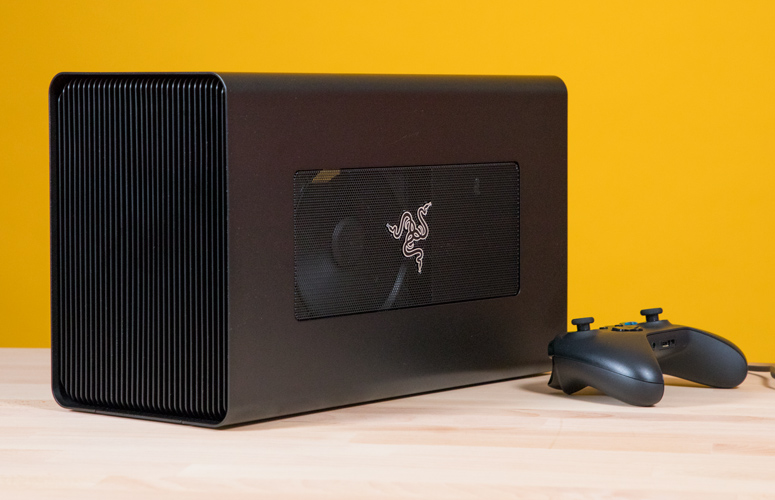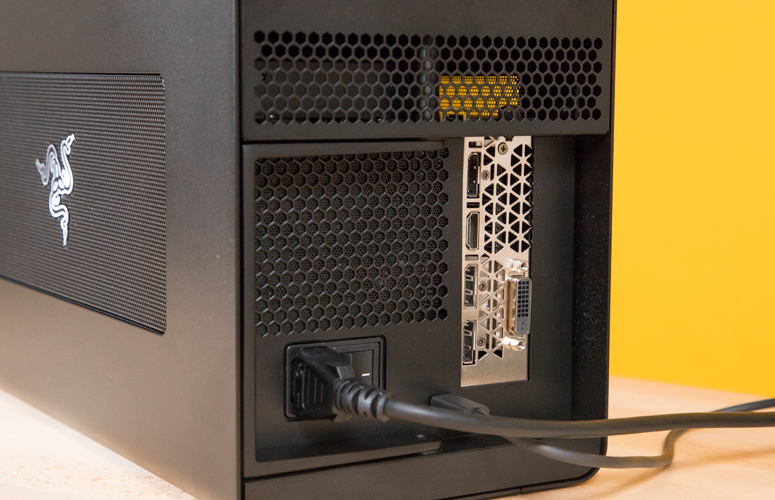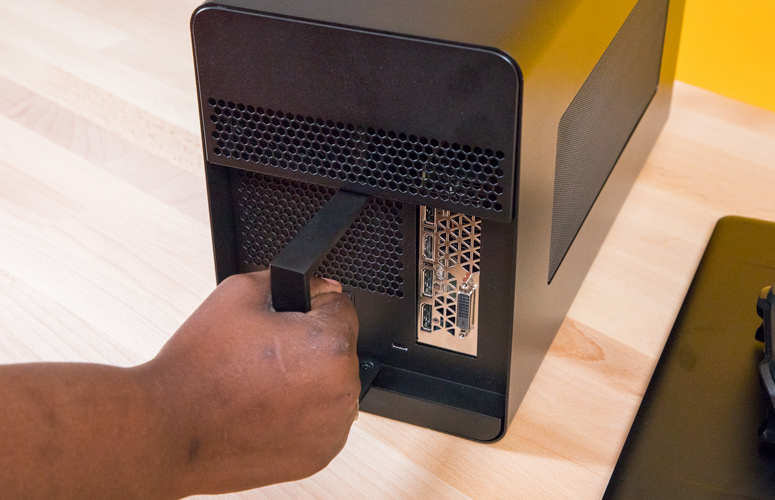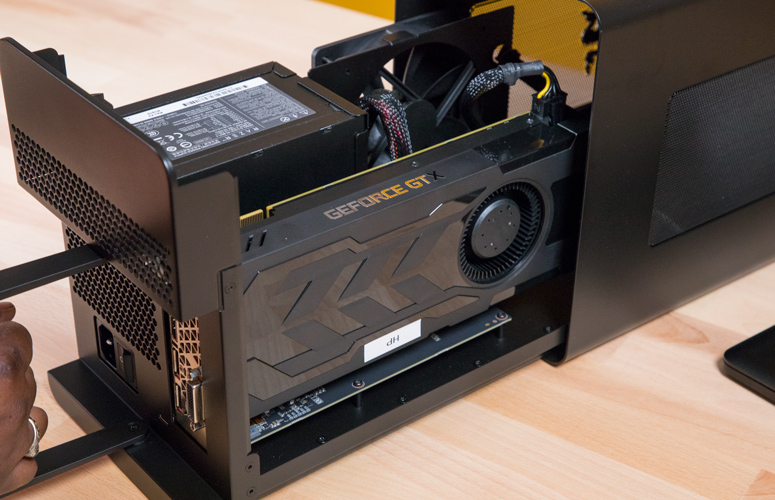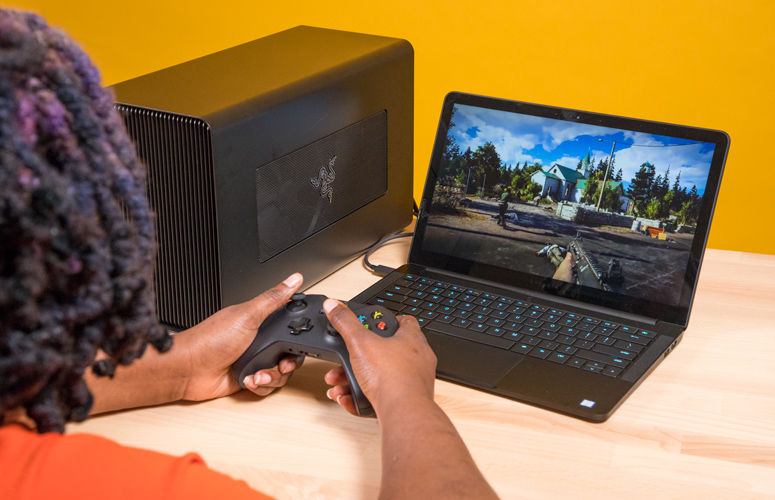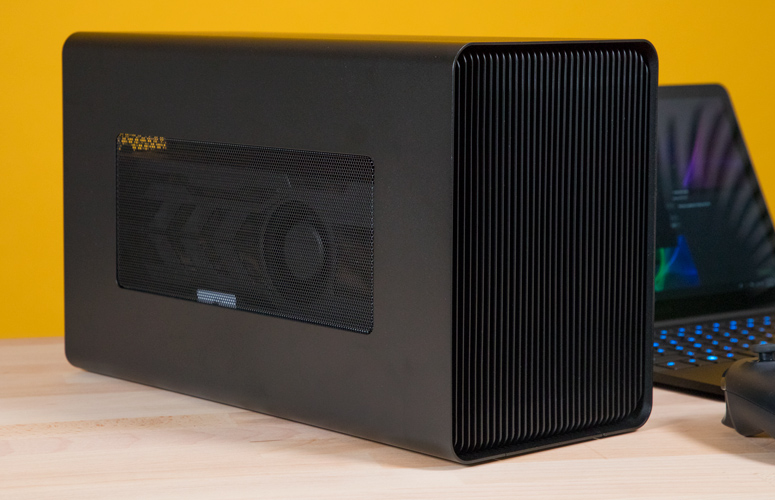Laptop Mag Verdict
The Razer Core X can fit the biggest graphics cards and turn your ultraportable laptop into the baddest gaming laptop in the land.
Pros
- +
Attractive, premium design
- +
Support for gaming and workstation GPUs
- +
Easy plug-and-play setup
- +
Affordable
Cons
- -
Fans can get loud
- -
Lacks USB 3.0 ports
Why you can trust Laptop Mag
When it comes to its laptops and eGPUs, Razer has become known for creating products with undeniable beauty and sometimes unattainable prices. That changes with the Razer Core X, the company's new $299 eGPU, which maintains the quality build materials that you've come to associate with the brand and puts them in a larger chassis to support bigger cards and a larger power supply.
That's not to say sacrifices haven't been made. You lose the Ethernet and USB 3.0 ports, as well as the customizable Chroma lighting. But overall, the Core X is the affordable eGPU you've been waiting for Razer to make.
Design: Bigger, with a Few Compromises
If you're looking to supersize your external graphics enclosure, the Core X is for you. While the Core V2 (10.1 pounds, 11.8 x 5.7 x 1.7 inches) was slightly larger than the original Core (10.8 pounds, 11.8 x 5.1 x 1.7 inches), the Core X eclipses both at 14.3 pounds and 14.7 x 9.1 x 6.6 inches -- all the better to fit a massive Nvidia GeForce Titan V, my dears. And the Core X is ultimately smaller than the HP Omen Accelerator, which weighs in at 12 pounds and measures 15.8 x 7.9 x 7.9 inches.
But size isn't the only change you'll see. Razer has ditched the quartet of USB 3.0 ports, as well as Ethernet along the rear of the device, leaving only the Thunderbolt 3 port and power input. However, the large quick-release handle is still mounted prominently, waiting for you to pull it and get to work installing a GPU.
Aside from the ports and size difference, the Core X has the same design as its predecessors. It's still made from jet-black CNC aluminum with the large, silver, tri-headed snake emblem on the left and a large peekaboo grate on the right to let you look at your GPU. As a cost-saving measure, Razer ditched the Chroma lighting, so your graphics card won't have the opportunity to be awash in the 16.8 million color options available in the Synapse software. The front, top and bottom of the Core X are lined with vents, ensuring the components housed within are kept nice and cool.
What's Left, and What's New?
Sign up to receive The Snapshot, a free special dispatch from Laptop Mag, in your inbox.
So Razer got rid of a few ports and the hypnotic Chroma lighting. What does the consumer get in return? For starters, a larger power source. The Core X rocks an ATX 650-watt power supply that's capable of running whatever GPU you install and delivering 100W of power to an attached laptop. The Core V2's slim 500W supply delivered only 65W.
Unlike its predecessors, the Core X can support graphics cards with three-slot PCIe brackets, like the EVGA GTX GeForce 1070 FTW Ultra Silent GPU. Third-party GPUs tend to have multiple fans and proprietary cooling solutions that need the extra space. Speaking of cooling, the Core X allows you to swap out the preinstalled 120-millimeter fan if one goes kaput or you have a preferred fan brand.
Mac users can also get in on the fun, as Razer has announced that both the Core X and the Core V2 now support Apple systems -- provided the machine in question has compatible specs, which, in most cases, aren't too rigorous.
Compatibility
Similar to the Core V2, the Core X supports a multitude of GPUs, including workstation-grade cards like those in Nvidia's Quadro line and AMD's Radeon Pro series of cards. And thanks to the Core X's bigger dimensions, it can also house ridiculously powerful graphics cards like the GeForce Titan V or the AMD Radeon RX Vega 64.
Similar to the Core V2, the Core X doesn't discriminate between laptops with dual or four-lane Thunderbolt 3 ports, which means that as long as your notebook has the right port and software, you're good to go. For the software, PC users need to have at least Windows 10 64-bit, while Mac users require at minimum High Sierra 10.13.4.
Gaming Performance
When is an ultraportable not an ultraportable? When it's connected to an eGPU. I turned the Razer Blade Stealth into a badass gaming laptop simply by connecting it to the Core X by way of a simple Thunderbolt 3 cable. I also successfully used the Core X with the HP Spectre 13 and the Dell XPS 13 and saw respectable scores that rival those of a regular gaming laptop, thanks to the GTX 1070 GPU we installed.
We started with the Rise of the Tomb Raider benchmark, which runs at the Very High setting at 1920 x 1080. The Stealth delivered 44 frames per second, matching the frame rate from the XPS 13 but falling slightly behind the Spectre, which played at 45 fps. When we ran the benchmark with the HP Omen Accelerator, each of the laptops managed to produce 45 fps.
I turned the Razer Blade Stealth into a badass gaming laptop simply by connecting it to the Core X by way of a simple Thunderbolt 3 cable.
During the Hitman test, the Core X pushed the Stealth to 66 fps, topping the Spectre's 48 fps. Still, that's slightly below the frame rate from the XPS 13, which achieved 68 fps. With the Omen Accelerator, the Stealth, Spectre 13 and XPS 13 obtained frame rates of 66, 56 and 55 fps, respectively.
MORE: The Best Gaming Laptops
Because the GTX 1070 is VR-ready, you can transform your ultraportable into a virtual-reality wonderland with an Oculus Rift, HTC Vive or Vive Pro. The Core X helped the laptops reach the high end of the SteamVR Performance test, with the Stealth, XPS 13 and Spectre 13 hitting 9.5, 9.3 and 9.1, respectively. The Omen Accelerator nearly matched every one of the Core X's results, with the Stealth notching 9.5, the Spectre 13 getting 9.4 and the XPS scoring 9.3.
Setup
If only everything could be as easy as setting up the Core X. Like Razer's other eGPUs, I accessed the interior of the enclosure by way of the Quick-release handle at the rear of the device. Next, I removed the single holding screw on the locking pin ramp and placed our Nvidia GeForce GTX 1070 GPU into the awaiting PCIe slot. From there, I replaced the holding screw to secure the GPU, and connected the plugs.
Unlike with the original Core, you don't have to restart the laptop for it to register that the Core V2 is attached; you simply connect it to the awaiting notebook, and you're ready to game. The fans can get a bit loud when you're gaming, but this might be different depending on the GPU.
If only everything could be as easy as setting up the Core X.
If I have one gripe, it's that I wish that Razer could have found a way to squeeze a hard drive or an SSD compartment into the Core X like HP did with the Omen Accelerator. It'd be nice to have everything you need in one box instead of potentially investing in an external hard drive.
Bottom Line
Razer takes a serious Maybelline approach to its tech -- easy, breezy, beautiful -- and it shows in the Core X. The $299 eGPU gives prospective gamers a larger chassis to house larger graphics cards while maintaining the sleek, premium looks we've come to expect from Razer. And the quick-release handle makes it incredibly easy to access the internals and install or remove a GPU as needed.
However, all that premium ease does come at the expense of the several ports and customizability. The latter drawback doesn't matter as much, but considering ultraportables like the Blade Stealth are already pretty light on ports, it could make it difficult to attach a phalanx of peripherals.
For the same price as the Core X, you could get the HP Omen Accelerator, which offers four USB ports and Ethernet connectivity. The HP system also offers a compartment to install an HDD or an SSD, which frees up your laptop's storage for other important files. But for all those gains, you get an absolutely massive eGPU that will monopolize your desk. Overall, the Razer Core X is an excellent choice for gamers who are looking for a sleek, minimal-frills eGPU.
Credit: Shaun Lucas/Laptop Mag
- Our Favorite Gaming Mice for Every Genre
- PS4 Games: Our Staff Favorites
- The Best Gaming Desktops Available Now
Razer Core X Specs

Sherri L. Smith has been cranking out product reviews for Laptopmag.com since 2011. In that time, she's reviewed more than her share of laptops, tablets, smartphones and everything in between. The resident gamer and audio junkie, Sherri was previously a managing editor for Black Web 2.0 and contributed to BET.Com and Popgadget.
